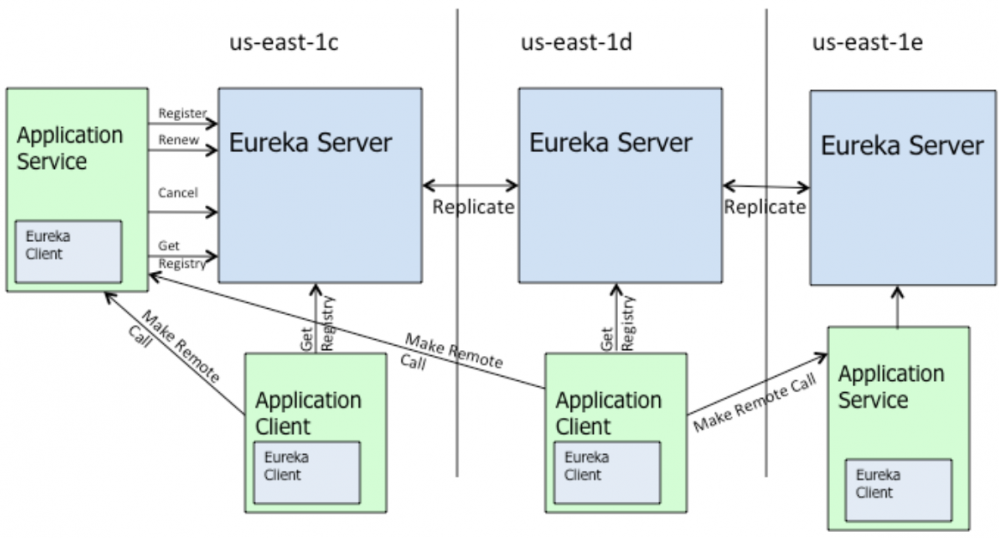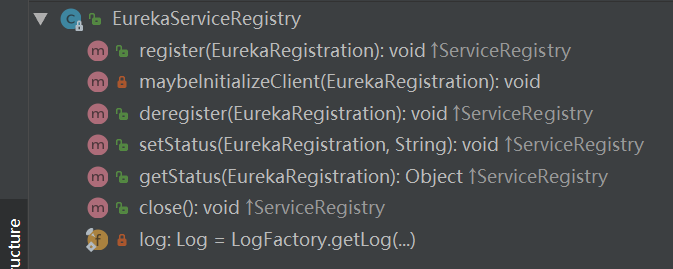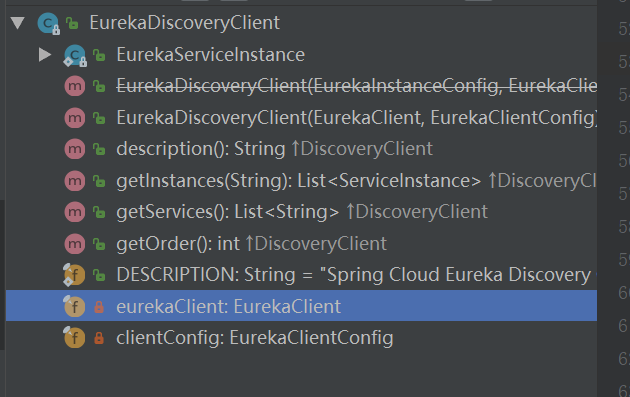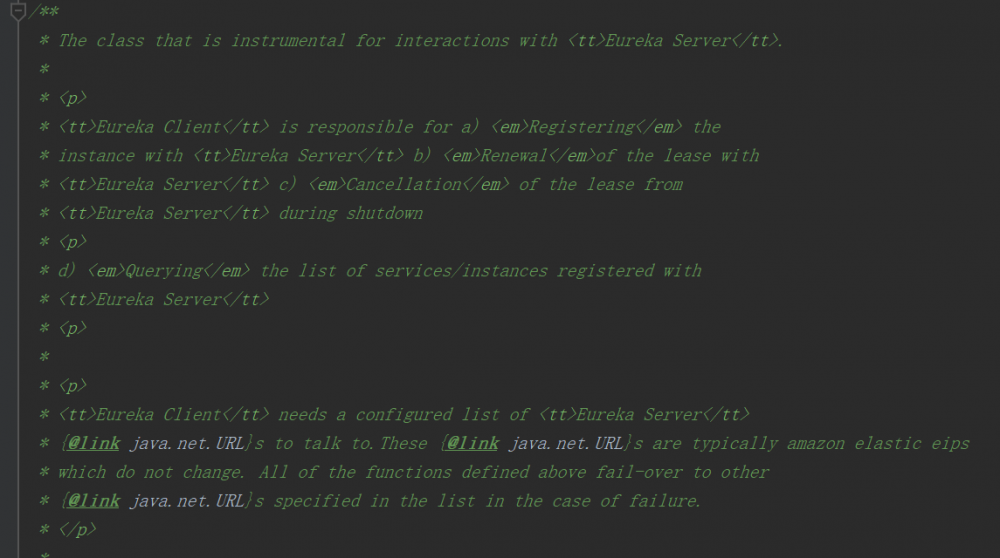EurekaClient 源码浅析
背景: 最近在研究springCloud,对服务注册中心也非常好奇,然后就看了一下源码,而且以后面试也需要了解一下,因此记录一下
注意:EurekaClient的内容很多,我只分析主干部分
前提: 这里的springboot版本为2.1.5.RELEASE,spring-cloud版本为Greenwich.SR1。
eureka架构图

从这里我们可以看到几个重要的概念:
Eureka可以向EurekaServer Register、Renew、Cancel、Get Registy,下面就分别这几个概念讨论吧。
根据springboot的自动配置特性,我们找到org.springframework.cloud.spring-cloud-netflix-eureka-client.2.1.1.RELEASE.spring-cloud-netflix-eureka-client-2.1.1.RELEASE.jar下面的META-INF/spring.factories。

最重要的就是 EurekaClientAutoConfiguration 这个配置类了
打开配置类EurekaClientAutoConfiguration截取一下重要的配置:
EurekaClientConfigBean
@Bean @ConditionalOnMissingBean(value = EurekaClientConfig.class, search = SearchStrategy.CURRENT) public EurekaClientConfigBean eurekaClientConfigBean(ConfigurableEnvironment env) { EurekaClientConfigBean client = new EurekaClientConfigBean(); if ("bootstrap".equals(this.env.getProperty("spring.config.name"))) { // We don't register during bootstrap by default, but there will be another // chance later. client.setRegisterWithEureka(false); } return client;}
复制代码
这个bean是eureka的配置信息,ymal配置的前缀是 eureka.client 开始的。这个配置类中有大量的eureka client默认配置。
比如:
1.默认的eureka配置:
/** * Default Eureka URL. */public static final String DEFAULT_URL = "http://localhost:8761" + DEFAULT_PREFIX + "/";复制代码
也就是说,如果没有配置eureka server的url,它会默认注册到本地8761地址中。
2.默认从eureka server中拉取配置时间间隔
/** * Indicates how often(in seconds) to fetch the registry information from the eureka * server. */private int registryFetchIntervalSeconds = 30;复制代码
也就是说默认每个30秒从eureka server中拉取一次所有服务的配置信息。
3.复制实例变化信息到eureka服务器所需要的时间间隔
/** * Indicates how often(in seconds) to replicate instance changes to be replicated to * the eureka server. */private int instanceInfoReplicationIntervalSeconds = 30;复制代码
还有很多配置可以自己去了解一下。
EurekaInstanceConfigBean
@Bean@ConditionalOnMissingBean(value = EurekaInstanceConfig.class, search = SearchStrategy.CURRENT)public EurekaInstanceConfigBean eurekaInstanceConfigBean(InetUtils inetUtils, ManagementMetadataProvider managementMetadataProvider) { String hostname = getProperty("eureka.instance.hostname"); boolean preferIpAddress = Boolean .parseBoolean(getProperty("eureka.instance.prefer-ip-address")); String ipAddress = getProperty("eureka.instance.ip-address"); boolean isSecurePortEnabled = Boolean .parseBoolean(getProperty("eureka.instance.secure-port-enabled")); String serverContextPath = env.getProperty("server.servlet.context-path", "/"); int serverPort = Integer .valueOf(env.getProperty("server.port", env.getProperty("port", "8080"))); Integer managementPort = env.getProperty("management.server.port", Integer.class); // nullable. String managementContextPath = env .getProperty("management.server.servlet.context-path"); // nullable. // should // be wrapped into // optional Integer jmxPort = env.getProperty("com.sun.management.jmxremote.port", Integer.class); // nullable EurekaInstanceConfigBean instance = new EurekaInstanceConfigBean(inetUtils); instance.setNonSecurePort(serverPort); instance.setInstanceId(getDefaultInstanceId(env)); instance.setPreferIpAddress(preferIpAddress); instance.setSecurePortEnabled(isSecurePortEnabled); if (StringUtils.hasText(ipAddress)) { instance.setIpAddress(ipAddress); } if (isSecurePortEnabled) { instance.setSecurePort(serverPort); } if (StringUtils.hasText(hostname)) { instance.setHostname(hostname); } String statusPageUrlPath = getProperty("eureka.instance.status-page-url-path"); String healthCheckUrlPath = getProperty("eureka.instance.health-check-url-path"); if (StringUtils.hasText(statusPageUrlPath)) { instance.setStatusPageUrlPath(statusPageUrlPath); } if (StringUtils.hasText(healthCheckUrlPath)) { instance.setHealthCheckUrlPath(healthCheckUrlPath); } ManagementMetadata metadata = managementMetadataProvider.get(instance, serverPort, serverContextPath, managementContextPath, managementPort); if (metadata != null) { instance.setStatusPageUrl(metadata.getStatusPageUrl()); instance.setHealthCheckUrl(metadata.getHealthCheckUrl()); if (instance.isSecurePortEnabled()) { instance.setSecureHealthCheckUrl(metadata.getSecureHealthCheckUrl()); } Map<String, String> metadataMap = instance.getMetadataMap(); metadataMap.computeIfAbsent("management.port", k -> String.valueOf(metadata.getManagementPort())); } else { // without the metadata the status and health check URLs will not be set // and the status page and health check url paths will not include the // context path so set them here if (StringUtils.hasText(managementContextPath)) { instance.setHealthCheckUrlPath( managementContextPath + instance.getHealthCheckUrlPath()); instance.setStatusPageUrlPath( managementContextPath + instance.getStatusPageUrlPath()); } } setupJmxPort(instance, jmxPort); return instance;}复制代码
这个主要是eureka client 这个几点自身的一些配置信息。
接下来是两个最主要的bean : DiscoveryClient 和 EurekaServiceRegistry
@Beanpublic DiscoveryClient discoveryClient(EurekaClient client, EurekaClientConfig clientConfig) { return new EurekaDiscoveryClient(client, clientConfig);}@Beanpublic EurekaServiceRegistry eurekaServiceRegistry() { return new EurekaServiceRegistry();}复制代码
EurekaServiceRegistry 用于服务注册,DiscoveryClient 用于服务发现
先看 EurekaServiceRegistry

我们看到这个类里面有几个方法:
register(EurekaRegistration reg) : 这个方法就是用于eureka client 注册到eureka server的,不过具体的注册逻辑不在这里。Eureka client的注册动作是在com.netflix.discovery.DiscoveryClient类的initScheduledTasks方法中执行的,其实最终的注册是发生在 InstanceInfoReplicator类里面的。
maybeInitializeClient(EurekaRegistration reg): 初始化 eureka client,eureka client 等会再说。
deregister(EurekaRegistration reg):注销下线操作,同样具体下线操作不在这里,这里只是将本节点实例状态设置为下线而已。
setStatus(EurekaRegistration registration, String status):设置本节点实例的状态。
getStatus(EurekaRegistration registration):获取本节点实例状态。
最后看一下DiscoveryClient,发现有两个DiscoveryClient,一个是类,一个是接口:

类是netflix提供的,接口时springcloud提供的。回到EurekaClientAutoConfiguration,它在声明DiscoveryClient这个bean的时候用的是EurekaDiscoveryClient
@Beanpublic DiscoveryClient discoveryClient(EurekaClient client, EurekaClientConfig clientConfig) { return new EurekaDiscoveryClient(client, clientConfig);}复制代码
找到 EurekaDiscoveryClient

发现EurekaDiscoveryClient里面包含netflix 里的EurekaClient接口,而这个接口的默认实现就是DiscoveryClient

也就是说EurekaDiscoveryClient和DiscoveryClient是组合模式,最后调用的还是netflix的类DiscoveryClient。这个类才是服务注册发现的关键,接下来分析这个类。
DiscoveryClient
先看看源码解释:

根据这么一段话,也就是说,这个类是用于和Eureka Server来交互,这个类的主要职责是:
a) <em>Registering</em> the instance with <tt>Eureka Server</tt> 服务注册
b) <em>Renewal</em>of the lease with <tt>Eureka Server</tt> 服务续约
c) <em>Cancellation</em> of the lease from <tt>Eureka Server</tt> during shutdown 服务下线
d) <em>Querying</em> the list of services/instances registered with <tt>Eureka Server</tt> 获取注册列表信息
DiscoveryClient构造器中的重要的方法 initScheduledTasks();
Fetch Registers : 获取注册列表信息
if(clientConfig.shouldFetchRegistry()){ //registry cache refresh timer int registryFetchIntervalSeconds = clientConfig.getRegistryFetchIntervalSeconds(); int expBackOffBound = clientConfig.getCacheRefreshExecutorExponentialBackOffBound(); scheduler.schedule(new TimedSupervisorTask("cacheRefresh" , scheduler, cacheRefreshExecutor, registryFetchIntervalSeconds, TimeUnit.SECONDS, expBackOffBound, new CacheRefreshThread()), registryFetchIntervalSeconds, TimeUnit.SECONDS);}复制代码
从上面的代码可以看出,eureka client 开启一个scheduler,每个一定的时间(默认是30秒,可以通过registryFetchIntervalSeconds配置)从eureka server 拉取eureka client的配置信息。进一步看到CacheRefreshThread这个runnable。
class CacheRefreshThread implements Runnable {
public void run() {
refreshRegistry();//主要定时执行该方法
}
}复制代码
进一步分析 refreshRegistry
void refreshRegistry() { try { ... // 定时获取注册信息 boolean success = fetchRegistry(remoteRegionsModified); if (success) { registrySize = localRegionApps.get().size(); lastSuccessfulRegistryFetchTimestamp = System.currentTimeMillis(); } ... } catch (Throwable e) { logger.error("Cannot fetch registry from server", e); }}复制代码
继续分析 fetchRegistry(boolean forceFullRegistryFetch)方法,里面最主要的是getAndStoreFullRegistry();来发送HTTP请求到注册中心来获取注册信息,并缓存到本地
private void getAndStoreFullRegistry() throws Throwable { ... Applications apps = null; EurekaHttpResponse<Applications> httpResponse = clientConfig.getRegistryRefreshSingleVipAddress() == null ? eurekaTransport.queryClient.getApplications(remoteRegionsRef.get()) : eurekaTransport.queryClient.getVip(clientConfig.getRegistryRefreshSingleVipAddress(), remoteRegionsRef.get()); if (httpResponse.getStatusCode() == Status.OK.getStatusCode()) { apps = httpResponse.getEntity(); } logger.info("The response status is {}", httpResponse.getStatusCode()); if (apps == null) { logger.error("The application is null for some reason. Not storing this information"); } else if (fetchRegistryGeneration.compareAndSet(currentUpdateGeneration, currentUpdateGeneration + 1)) { // 把拉取的信息缓存在 localRegionApps 中 localRegionApps.set(this.filterAndShuffle(apps)); logger.debug("Got full registry with apps hashcode {}", apps.getAppsHashCode()); } else { logger.warn("Not updating applications as another thread is updating it already"); }}复制代码
而那个localRegionApps 就是用于缓存拉取信息的
private final AtomicReference<Applications> localRegionApps = new AtomicReference<Applications>();复制代码
Renew 服务的续期
回到initScheduledTasks()方法,
if(clientConfig.shouldRegisterWithEureka()){ ... // Heartbeat timer scheduler.schedule(new TimedSupervisorTask("heartbeat", scheduler, heartbeatExecutor, renewalIntervalInSecs, TimeUnit.SECONDS, expBackOffBound, new HeartbeatThread()), renewalIntervalInSecs, TimeUnit.SECONDS); ...}else{ logger.info("Not registering with Eureka server per configuration");}复制代码
进一步看 HeartbeatThread 这个Runnable
/** * The heartbeat task that renews the lease in the given intervals. */private class HeartbeatThread implements Runnable { public void run() { if (renew()) { lastSuccessfulHeartbeatTimestamp = System.currentTimeMillis(); } }}复制代码
/** * Renew with the eureka service by making the appropriate REST call */boolean renew() { EurekaHttpResponse<InstanceInfo> httpResponse; try { httpResponse = eurekaTransport.registrationClient.sendHeartBeat(instanceInfo.getAppName(), instanceInfo.getId(), instanceInfo, null); logger.debug(PREFIX + "{} - Heartbeat status: {}", appPathIdentifier, httpResponse.getStatusCode()); if (httpResponse.getStatusCode() == Status.NOT_FOUND.getStatusCode()) { REREGISTER_COUNTER.increment(); logger.info(PREFIX + "{} - Re-registering apps/{}", appPathIdentifier, instanceInfo.getAppName()); long timestamp = instanceInfo.setIsDirtyWithTime();
// 注册 boolean success = register(); if (success) { instanceInfo.unsetIsDirty(timestamp); } return success; } return httpResponse.getStatusCode() == Status.OK.getStatusCode(); } catch (Throwable e) { logger.error(PREFIX + "{} - was unable to send heartbeat!", appPathIdentifier, e); return false; }}复制代码
以上代码是每隔一定时间去发送心跳(默认30秒),如果返回的结果是404,就把client注册到Eureka Server上。
Register 服务注册
/** * Register with the eureka service by making the appropriate REST call. */boolean register() throws Throwable { logger.info(PREFIX + "{}: registering service...", appPathIdentifier); EurekaHttpResponse<Void> httpResponse; try { httpResponse = eurekaTransport.registrationClient.register(instanceInfo); } catch (Exception e) { logger.warn(PREFIX + "{} - registration failed {}", appPathIdentifier, e.getMessage(), e); throw e; } if (logger.isInfoEnabled()) { logger.info(PREFIX + "{} - registration status: {}", appPathIdentifier, httpResponse.getStatusCode()); } return httpResponse.getStatusCode() == Status.NO_CONTENT.getStatusCode();}复制代码
这个方法实在DiscoveryClient类中的。
在DiscoveryClient.initScheduledTasks()中,有一段这么代码
// InstanceInfo replicatorinstanceInfoReplicator = new InstanceInfoReplicator( this, instanceInfo, clientConfig.getInstanceInfoReplicationIntervalSeconds(), 2); // burstSize...instanceInfoReplicator.start(clientConfig.getInitialInstanceInfoReplicationIntervalSeconds());复制代码
在InstanceInfoReplicator 构造方法中会创建一个scheduler。注册方法的调用是通过InstanceInfoReplicator.instanceInfoReplicator.start(clientConfig.getInitialInstanceInfoReplicationIntervalSeconds())发送注册请求到注册中心
public void start(int initialDelayMs) { if (started.compareAndSet(false, true)) { instanceInfo.setIsDirty(); // for initial register Future next = scheduler.schedule(this, initialDelayMs, TimeUnit.SECONDS); scheduledPeriodicRef.set(next); }}复制代码
public void run() { try { discoveryClient.refreshInstanceInfo(); Long dirtyTimestamp = instanceInfo.isDirtyWithTime(); if (dirtyTimestamp != null) { // 注册 discoveryClient.register(); instanceInfo.unsetIsDirty(dirtyTimestamp); } } catch (Throwable t) { logger.warn("There was a problem with the instance info replicator", t); } finally { Future next = scheduler.schedule(this, replicationIntervalSeconds, TimeUnit.SECONDS); scheduledPeriodicRef.set(next); }}复制代码
Cancel: 服务下线:
这个方法实在DiscoveryClient类中的。
/** * unregister w/ the eureka service. */void unregister() { // It can be null if shouldRegisterWithEureka == false if(eurekaTransport != null && eurekaTransport.registrationClient != null) { try { logger.info("Unregistering ..."); EurekaHttpResponse<Void> httpResponse = eurekaTransport.registrationClient.cancel(instanceInfo.getAppName(), instanceInfo.getId()); logger.info(PREFIX + "{} - deregister status: {}", appPathIdentifier, httpResponse.getStatusCode()); } catch (Exception e) { logger.error(PREFIX + "{} - de-registration failed{}", appPathIdentifier, e.getMessage(), e); } }}复制代码
这个方法的调用是通过 shutdown() 方法的
/** * Shuts down Eureka Client. Also sends a deregistration request to the * eureka server. */@PreDestroy@Overridepublic synchronized void shutdown() { if (isShutdown.compareAndSet(false, true)) { logger.info("Shutting down DiscoveryClient ..."); if (statusChangeListener != null && applicationInfoManager != null) { applicationInfoManager.unregisterStatusChangeListener(statusChangeListener.getId()); } cancelScheduledTasks(); // If APPINFO was registered if (applicationInfoManager != null && clientConfig.shouldRegisterWithEureka() && clientConfig.shouldUnregisterOnShutdown()) { applicationInfoManager.setInstanceStatus(InstanceStatus.DOWN); unregister(); } if (eurekaTransport != null) { eurekaTransport.shutdown(); } heartbeatStalenessMonitor.shutdown(); registryStalenessMonitor.shutdown(); logger.info("Completed shut down of DiscoveryClient"); }}复制代码
这个方法上有个注解@PreDestroy,表示在对象销毁之前触发的。可以看到这个方法中关闭了定时任务,通知eureka server 下线。
以上就是我对Eureka client的理解,
总结:
1.springcloud 整合了netflix,通过组合模式, EurekaDiscoveryClient 包含 EurekaClient, 核心功能都是由 DiscoveryClient 来完成的。
2.Eureka client 主要有 Register、Renew、Cancel、Get Registy功能。
3.Eureka client和Server的交互通过大量的定时任务触发,交互通过http协议,设计核心类为 EurekaHttpClient。
4.在DiscoveryClient被创建的时候,在其构造方法中,启动了三个线程池,然后分别启动了三个定时器任务:注册当前服务到注册中心;持续发送心跳进行续约任务;定时刷新注册中心注册细信息到本地,所以可以说,在项目启动的时候这些任务就被执行了。
- 本文标签: 总结 update message https IDE IO value equals entity remote Service apr CTO bug final rand ssh 线程池 ip UI executor 实例 服务注册 src 源码 Property cat 时间 springboot REST 缓存 spring http servlet cache Region URLs 注册中心 client 协议 Atom 线程 代码 id Eureka synchronized ECS ORM 配置 parse Netflix provider 服务器 Transport tar Bootstrap HTTP协议 list 构造方法 ask heartbeat bean map App springcloud
- 版权声明: 本文为互联网转载文章,出处已在文章中说明(部分除外)。如果侵权,请联系本站长删除,谢谢。
- 本文海报: 生成海报一 生成海报二











![[HBLOG]公众号](https://www.liuhaihua.cn/img/qrcode_gzh.jpg)

